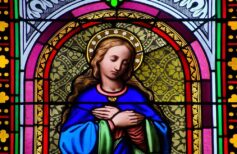The apocryphal gospels are not part of the New Testament: what differentiates them from the Gospels of Mark, Matthew, Luke and John, considered canonical?
Contents
We all know, thanks to the accounts of the Gospels of Matthew and Luke, that Jesus was born in Bethlehem. But where do the images of the cave, the ox and the donkey next to the manger that warms Jesus with their breath come from? These details do not appear in the gospels of Luke and Matthew but in the apocryphal gospels. The word “apocryphal” comes from the Greek and indicates something kept hidden and away from use. In the Christian context, it is used for texts that are not part of the four canonical gospels and are not recognized as part of the New Testament.

Saint Matthew, apostle, evangelist and martyr
On 21 September, Saint Matthew is celebrated evangelist, apostle and martyr. Who was he and how did he become an apostle?
The Apocrypha
The apocryphal gospels are texts, mostly fragmentary, that tell facts of the history of Jesus and the people around him, but that were not accepted as canonical by the magisterium of the Church. These texts were produced after the Apostolic Age, that is, in the decades following the preaching of the Apostles and the birth of the first Christian communities, probably because of the need to enrich the Christian teachings with additional information and explanations.
Most apocryphal gospels do not distort the facts described in the four canonical gospels, but add interpretations or anecdotes of dubious veracity. In some cases, the apocryphal gospels were born from the influence of other currents of thought, such as Gnosticism, considered heretical positions not in line with the Church’s teaching.
Apocrypha are classified into several groups:
- Gospels of childhood: focus on the childhood period of Jesus and the figures of Mary and Joseph
- Judeo-Christian Gospels: Inspired by late Judaism in the in terpretation of Jesus’ life
- Gnostic gospels: are influenced by the current of Gnosticism
- Passion Gospels: Focus on the Passion of Christ
- Other apocryphal gospels, fragments, lost and homonymous
Differences between canonical gospels and apocrypha
It is thought that the Apocrypha were written in the second century A.D. and therefore much later than the preaching of the apostles. In the case of the canons, however, the three synoptic gospels are all dated to the second half of the first century and the gospel of John, the most recent, between 95 and 110 A.D. The temporal distance in the drafting of the apocryphal texts implies a doubt on the authenticity of the messages present because they are hardly attributable to the direct teaching of the apostles.
To decree the theological acceptability of the New Testament texts, in fact, the ancient Christian Church believed in four essential principles:
- the holy tradition
- Apostolic fatherhood: the text must be attributed to the apostles or to people in close contact with them
- Liturgical use: the text was used in the liturgies of the first Christian communities
- Orthodoxy: the text must respect the dogmatic truths of the faith, such as the Unity and Trinity of God and the coexistence of human and divine nature in Jesus Christ.
A further difference between apocryphal and canonical gospels lies in the literary form and content. The apocryphal gospels are often characterized by devotional tales rich in detail, with legendary or fable traits, which seem to be born from popular piety.

Holy Trinity: meaning and iconographic representation
The concept of Trinity summarises the fundamental doctrine of the Catholic Church: God is One and Only.
Apocryphal and Gnostic Gospels
As we have said, some of the apocryphal gospels refer to Gnosticism. It is a philosophical and spiritual current, partly linked to ancient esoteric religions, according to which the soul is saved thanks to a higher and enlightened knowledge, derived from personal experience and search for truth. From the beginning, Christian-Gnostic interpretations were considered heretical by the Church: according to ecclesial doctrine in fact man cannot save himself alone, but he needs the Saviour.
Here are the main apocrypha gnostics:
- the Greek gospel of the Egyptians
- the gospel of Matthias
- the gospel of Mary Magdalene
- the gospel of Judah
- the apocryphal of John
- the Sophia (wisdom) of Jesus
- the Gospel of Thomas
- the Gospel of Peter
We have deepened the theme of the Gospel of Judas in our article dedicated to Judas Iscariot. This text, starting from a Gnostic basis, argues that betrayal was a mission entrusted to Judas by Jesus himself. The apocrypha attributed to St Matthias, St John and St Peter are an example of pseudepigraphic attribution: it was erroneously thought that the three apostles were the authors.

24 June Saint John the Baptist
On 24 June we celebrate the birth of Saint John the Baptist, one of the most venerated Saints in the world.


























